Menus
- One like none
- "Golden key"
- Running culture
- Once in a lifetime …
- Data Honda CB 900 F Bol d ?? Or (1981)
- History Honda Bol d’Or
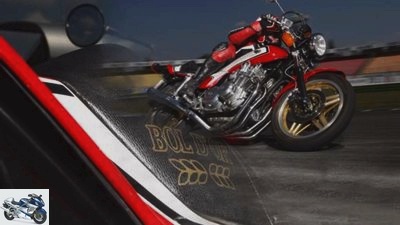
Artist
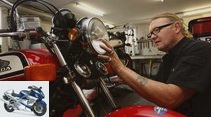
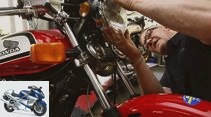
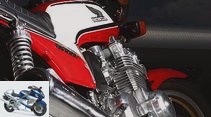
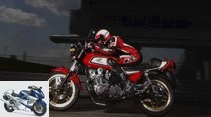
26th photos
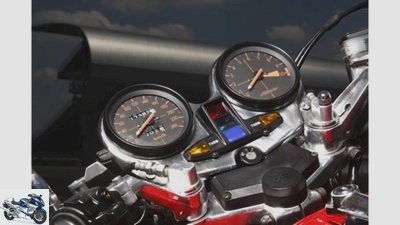
Artist
1/26
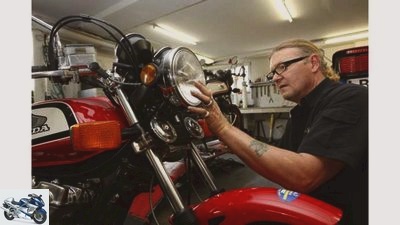
Artist
2/26
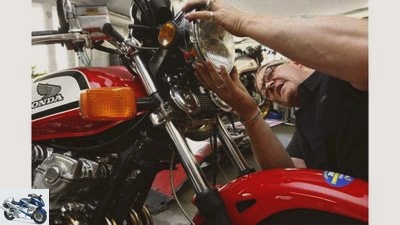
Artist
3/26
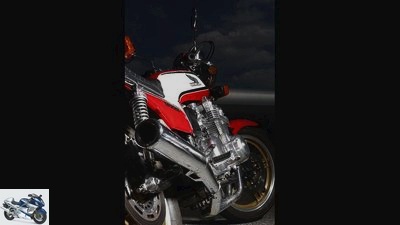
Artist
4/26
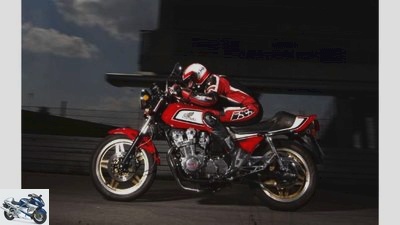
Artist
5/26

Artist
6/26
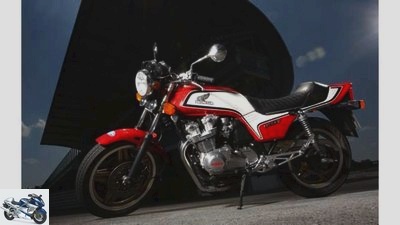
Artist
7/26
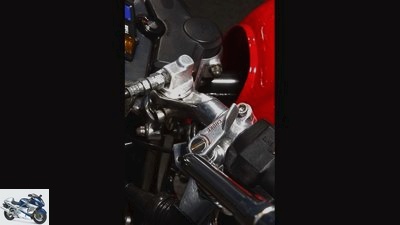
Artist
8/26
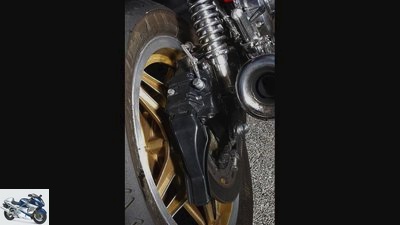
Artist
9/26
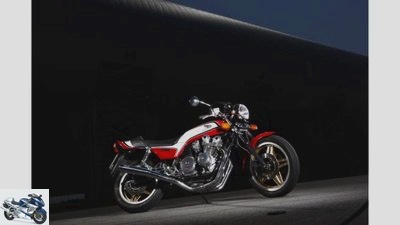
Artist
10/26
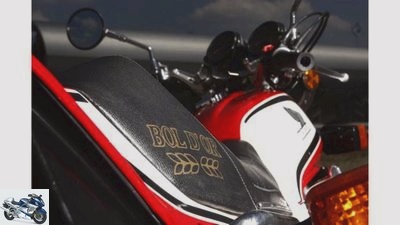
Artist
11/26
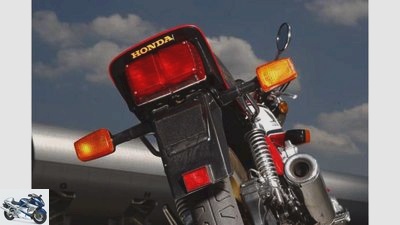
Artist
12/26
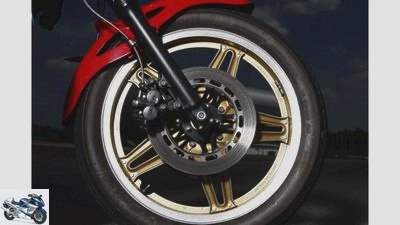
Artist
13/26

Artist
14/26
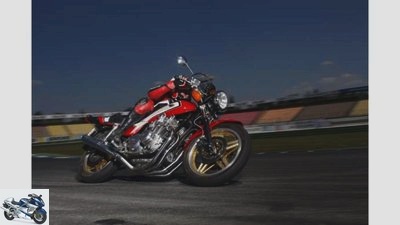
Artist
15/26
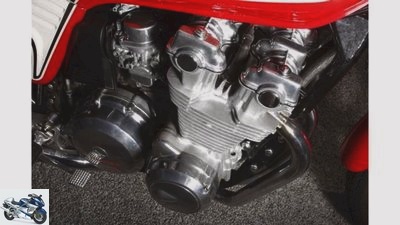
Artist
16/26
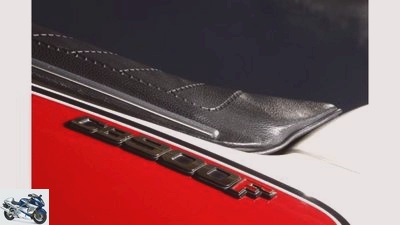
Artist
17/26
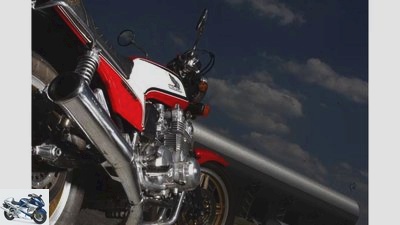
Artist
18/26
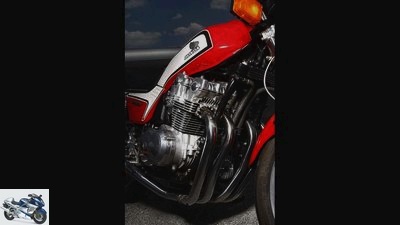
Artist
19/26
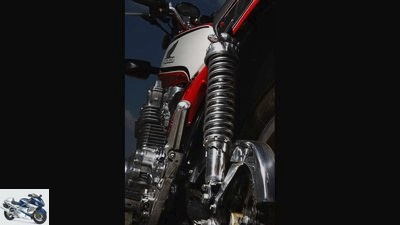
Artist
20/26
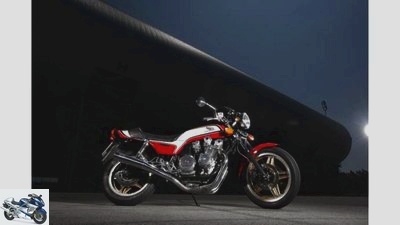
Artist
21/26
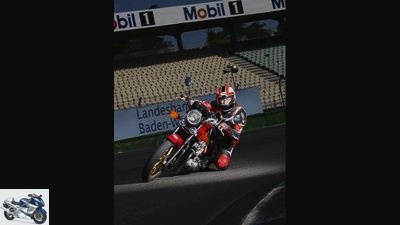
Artist
22/26
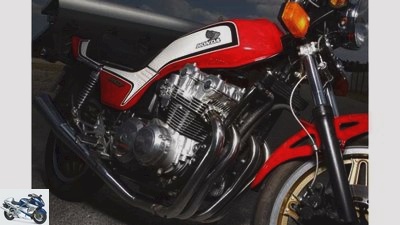
Artist
23/26
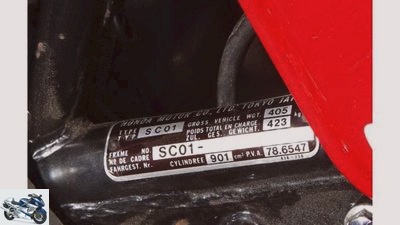
Artist
24/26
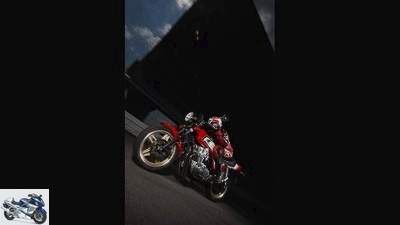
Artist
25/26
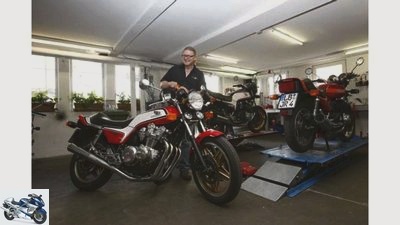
Artist
26/26
Hobby motorcycle Honda CB 900 F Bol d ?? Or
One like none
No late 70s sports motorcycle sold as well as the Honda CB 900 F. Thousands of copies still exist after almost 30 years. But a very specific, special Bol d´Or has cast a spell over the author of this article.
"I had one like that too!" The lanky mid-fifties circles the Bol d’Or like a moth around the light. "Exactly one of those?" I ask back. A CB 750, 900 or 1100? "No, no, the right one, the real Bol d’Or. The one with 900 cubic." And he tells how it was back when 95 hp was considered the end of the flagpole. This Honda is an ambassador from a bygone era. When sports motorcycles still had a metallic aura, chrome, aluminum and steel still triumphed over plastic, visible from afar. However, there was not so much shine as standard even in 1981, the year it was built "SC 01". She is like none. Previous owner Oli has done a lot of work polishing the handlebars, the engine case cover and even the valve cover. In addition, the horns and the lamp were exchanged for completely chrome-plated specimens. There are also parts of the CB 1100 F "Super Bol d’Or" like the filigree footrest carrier, logical, polished. The aesthetic lacquer design also comes from the 1100, in which the black decorative stripe on the side cover looks like an EKG curve. Yes, increased heartbeat, that was it.
Even for me, as a late bloomer, however, when I saw that motorcycle as a test machine two years ago, in the photos of Werner’s big youngtimer tire test "Mini" Koch (MOTORRAD 14/2006). Mini was able to establish contact with Oli, but he didn’t want to sell this 900: "I built it up myself that way. I’ll get you another nice one", The Bol d’Or self-made expert promised (www.olis-motorradbox.de). Two months later a call: "Hi, Oli here. I’m pretty broke. Are you still interested in the Bolle?" You bet! We agreed on 2750 euros. Not a little for a 25 year old motorcycle. Virtually nothing for a dream.
"Golden key"
Artist
Forms that have lost none of their charm.
After all, the Bol d´Or was the sports motorcycle par excellence from 1978, and its name is full of sound. Back then, Honda still dared to name a motorcycle after a race. What an appearance, what an image. Racing technology from long-distance racing for the road, which was very popular at the time, was not available anywhere else. The series machine was not a real replica, rather a bow to the victorious endurance machines that put away 24 hours of full throttle without complaint. From 1976 to 1979 they won the endurance world championship including the legendary races in Le Mans around the Bol d’Or, in German: golden bowl. A myth was born, for everyone to buy.
Honda’s first twin-cam engine carried the 900 series, alongside the CB 750 K, which was also presented in 1978. Its four plugs on the camshafts looked out into the world like sparkling eyes. Four bends, confidently held in the wind. Four cylinders coupled with 16 valves and immense performance. Everything is similar to the racing machines with their special “RCB” engine. Racing genes shimmered through in other ways too. The CB 900 F was the first production motorcycle to have fully adjustable suspension struts, i.e. in preload, rebound and compression damping (see suspension strut test for youngtimers in the upcoming issue of MOTORRAD CLASSIC 5/2008). From 1981, including mine, the slender 35 fork was exchanged for a more stable 37 component, and all three disc brakes were given double-piston floating calipers. From now on, a spoiler on the front mudguard directed cooling airflow onto the oil cooler.
In 1981 the beautiful, fully disguised “F2” was released. Michael, my brother-in-law’s brother, had one of those. It made him the king of our “ghetto”, as we called our 60s district in Marl-Huls, located on the northern edge of the Ruhr area. A Bol d’Or was already a legend. I was 15 years old and stood in awe in front of the huge, red and white motorcycle. With my mouth open, I listened to stories of the rear tires being rubbed after 2000 kilometers or of 911 Porsches losing their weight at over 200 … Today, more than half a life later, the world is no longer the same. You notice that as soon as you approach the red-white-black beauty. Motorcycles smelled better then than they do now, really true. They offered all the senses more projection surface.
Running culture
Taking a seat on the retrofitted Giuliari bench means boarding an island in time. "Snap" does the folding side stand, because the circuit breaker was not yet invented. With its pronounced hump, this is hard seating furniture "made in Italy" a pronounced one and a half seater. Hardly hip back then. Two of you have to cuddle up on it. The driver sits stretched out, quite high up and far away from the front wheel. It is almost impossible to close the knee on the long, narrow 20 liter tank. Ergonomics, today’s motorcycles can do better. Begin! If the alternator doesn’t strike again, the CB comes at the first push of a button. The warm-up speed can be adjusted precisely from the handlebars using the metal choke lever (!). The four Keihin carburettors are sensitive to the gas. If the idle speed drops too low, the transmission rumble, a Bol d’Or disease. So better a few throttles. Then you can no longer hear the colorful mechanical noises so clearly. The three tooth chains, for example. For the primary drive, from the crankshaft to the exhaust and from there to the intake camshaft. The four-in-one exhaust system from Sebring sounds dull, throaty, but not loud and proletarian. It is obviously a real relief: The series 900 weighed a whopping 260 kilograms, mine are "just" 248 kilos.
The long-stroke, unthinkable on a sports motorcycle today, energetically starts from the bottom. At the top, however, it becomes tougher and only swings up to the nominal speed of 9000 with difficulty. Vibrates violently and feels more like 75 than 95 hp. Or have the sensations just shifted that way? The optimistic speedometer needle only trembles to 200 when running. Downhill there are 220 in it. Today an ER-6n has more pressure. But aura? No way. The spirit of yore turns on. Fold yourself up small and be happy that the youngtimer does not commute today because you are holding the narrow handlebar stubs, not cramped, but nice and loose. In fast corners there is still a noticeable stir in the framework. The completely underdamped Showa fork with lush 160 millimeters of spring travel just pops out because it needs thicker oil. After all, she speaks super fine.
Once in a lifetime …
Artist
Good care: Oli, previous owner and experienced mechanic, during his pit stop "Motorcycle box".
What’s going on? This question is just as relevant today with the 900 as it was almost 30 years ago. In Hockenheim we shot the whorl in front of empty grandstands. And lo and behold: kneel on the ground, that is quite possible. Thanks to the four-in-one, the lean angle is surprisingly high. The accuracy? Not that bad. And the handling is very okay, despite the 18-inch rear and huge 19-inch front. Because the tires are nice and narrow and tip over easily. The Conti TKV 11 and 12 adhere well, as the second place after the famous Bridgestone BT 45 already proved in the all-important tire test at the time. The front brakes require an iron hand, combine, by today’s standards, moderate effect with poor controllability, despite retrofitted steel flex lines.
Anyway, in 2007 we were in the Thundersprint, a crazy sprint race in England. Where you get back to the start after 400 meters and three bends. 9th place out of 85 starters. The CB only ran on three cylinders because the piston rings were damaged and a spark plug was oily. Directed Bol d´Or-Oli later, together with the crooked inlet valves. Apparently the 900 was a tricky model, given Honda’s otherwise outstanding quality and reliability. At the beginning of July 2008, at the "Bikers Classics" in Spa-Francorchamps, the Bolle went very well. She felt very comfortable on the seven kilometer long, fast course, between a total of 800 other classic motorcycles while driving freely. Spectators stood in the stands, cameras clicked. Since then she has proudly worn fine rubber beads on the sidewalls. The 1981 Honda advertisement is true: "Once in a lifetime you have to drive Bol d’Or."
Data Honda CB 900 F Bol d ?? Or (1981)
Artist
The power of Japan is concentrated in the engine of the Bol d’Or.
engine
Four-cylinder four-stroke, air-cooled, bore / stroke: 64.5 / 69.0 mm, displacement: 902 cm³, compression 8.8: 1, power: 95 PS (70 kW) at 9000 rpm, maximum torque: 77 Nm at 8000 / min, four Keihin carburetors, Ø 32 mm, five-speed claw gear, chain drive.
landing gear
Double-loop tubular frame made of steel, front telescopic fork, Ø 37 mm, two-arm swing arm with two spring struts, a total of three disc brakes with double-piston floating calipers, Ø 265 mm each, tires: 100/90 V19 and 120/90 V18.
mass and weight
Tank capacity 20 liters, weight 260 kilograms.
price
9324 marks (4767 euros)
History Honda Bol d’Or
At the end of 1978, the CB 900 F Bol d’Or, the road offshoot of Honda’s long-distance racing machine, which won several world titles with a four-valve cylinder head, caused a sensation. The sporty F was joined by the CB 900 F2 (center) in 1981. Its full paneling was as expansive as it was elegant. The most beautiful sports tourer of the early 80s. Two years later, the CB 1100 Super Bol d’Or appeared. With a full 100 hp, a beguilingly beautiful paint kit and engine and exhaust system in black.
Related articles
-
TYGA Street NX-5 Honda RS 250 R-S Street racing motorcycle
TYGA performance 34 photos TYGA performance 1/34 In the 1990s, the Honda RS250R was a hot topic in the 250cc Grand Prix class. TYGA performance 2/34 In…
-
Technology 20 years of progress in motorcycle construction: Honda Fireblade – old against new
fact 14th photos fact 1/14 At the end of 1991 Honda presented the first Fireblade and shook the athlete Olympus permanently. We compare the Fireblade SC…
-
warrior 12th photos Sven Krieger 1/12 Cult bike Honda CB 450. Sven Krieger 2/12 Among the descendants: machines like the CB 500 (left) have long been…
-
Impression Honda CB 750 Four Fit for Four Some men believe that they have to plant trees, father sons or kick certain single-cylinders in order to…
-
Klaus H. Daams 26 pictures Klaus H. Daams 1/26 This is where motorcycle history meets. Klaus H. Daams 2/26 “LTD” insignia: Maroon paint, golden rims …
-
On the move with the Honda XL 600 V Transalp
Volker Rost 26th photos Peoples rust 1/26 Honda XL 600 V Transalp. Peoples rust 2/26 Until then, Honda had not had any luck with two-cylinder enduros….
-
archive 10 photos archive 1/10 The choke in the disguise oozes Spartan charm. archive 2/10 Gas factory: four Keihin constant pressure carburetors in the…
-
On the move with the Honda CBX 550 F2
Fred Siemer, Archive, Honda 18th photos Fred Siemer, Archive, Honda 1/18 On the move with the Honda CBX 550 F2. Fred Siemer, Archive, Honda 2/18 The…
-
Artist On the move: Honda VFR 750 R The top of Mount Olympus Content of The Honda VFR 750 R has earned a special nimbus and a place high on the honor…
-
Test BMW R 1100 S against Honda VTR 1000 F
Honda VTR 1000 F Fire Storm Comparison test, BMW R 1100 S, Honda VTR 1000 F Firestorm BMW R 1100 S versus Honda VTR 1000 F “The R 1100 S is not a super…